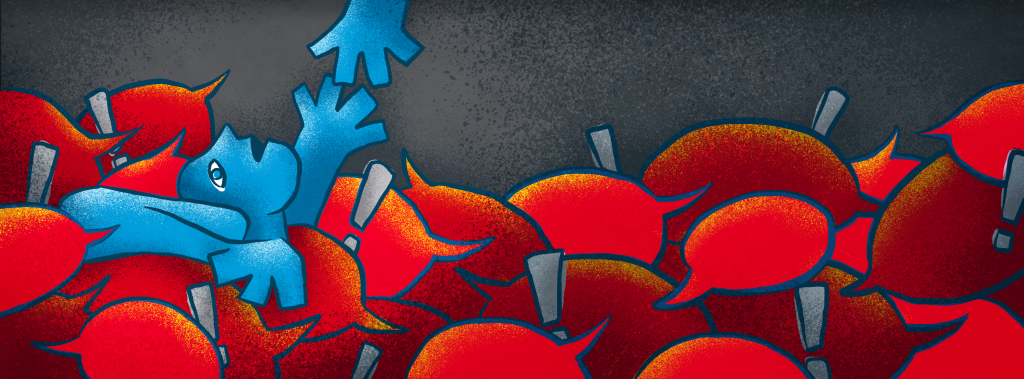
Hey Social Media,
I remember when we first met. You were like a vibrant town square buzzing with life, a place where every voice could be heard. I’ve connected with graduate students sharing their 3 AM study struggles, applauded working mothers speaking out against workplace discrimination, and been inspired by ordinary women’s quiet acts of courage.
But something has changed. When did this space become so hostile?
The statistics are alarming: 57% of young women experience online harassment, with most choosing to silently withdraw rather than confront it. Margaret Atwood’s profound words echo here: “Men fear women might laugh at them. Women fear men might kill them”.
Introduction

Let’s be clear: hate speech is more than just offensive language. It functions as a weaponized slur in digital form, systematically dehumanizing individuals based on gender, race, or other identities (Flew, 2021). In today’s hyperconnected world, a single toxic post can go viral before you finish your morning coffee. What’s most alarming is how predictably this vitriol targets women, not for their actions or opinions, but simply for existing in online spaces.
Gendered hate speech follows a distinct pattern. While criticism of a woman’s work may be harsh, true hate speech attacks her very right to participate in public discourse. Consider a female journalist: labeling her “unqualified” may be unfair, but calling her a “slut who belongs in the kitchen” constitutes hate speech (IMS, 2023). The former critiques her abilities; the latter denies her right to a professional presence.
The internet promised to give everyone an equal voice, but for women, this promise has been broken. Three main problems created this hostile environment: Anonymity allows harassment: people say cruel things online they would never say in person; Old stereotypes persist: Many people still believe women should be quiet and agreeable; Visibility brings backlash: The more women speak up, the more abuse they face.
It’s a sad truth that helping women share ideas also give power to trolls who think sexist jokes are funny. It isn’t about women being “too sensitive”, instead it’s about a system that tolerates discrimination. When women need thick skin just to post online, something is deeply wrong.
Change is possible, but it requires real effort: Social media companies must take responsibility and stop hate speech; We must call out sexism when we see it in our own networks; We need to stop excusing abuse as “just part of the internet”. The online world reflects society’s worst attitudes. If we want it to change, we can’t stay silent.
why do these evil comments against women appear?

The truth about online harassment of women is painfully clear. It isn’t some new digital phenomenon but rather ancient sexism dressed in modern clothes. For centuries, society has told women they’re less capable, less logical, and less deserving of a public platform. While feminist movements have forced these prejudices to become less socially acceptable, they never truly went away. They just learned to hide behind so-called jokes, subtle insults, and the same old double standards we all know too well.
What makes this digital version particularly dangerous is how easily it spreads. A sexist remark that might have been whispered among a small group in the past can now go viral in minutes, reaching thousands while hiding behind the anonymity of a screen.
Online spaces magnify this dynamic. When women speak up in male-dominated arenas like gaming, tech, or politics, the backlash follows a predictable pattern. It’s never just disagreement. Competence gets questioned, appearance becomes fair game, and for those making real waves, threats inevitably follow. The underlying message remains unchanged: women should know their place.
Research confirms what lived experience already shows: gender inequality drives this abuse (Malin Jirovsky, 2022). The internet exacerbates the problem through several key factors:
First, anonymity empowers behavior that would be unthinkable in face-to-face interactions. Then there’s mob mentality, where one cruel comment gives others permission to join the attack. Social algorithms compound the issue by actively promoting controversial content, meaning the most offensive posts often gain the widest reach. Meanwhile, inadequate moderation means perpetrators face few consequences, while victims bear the emotional labor of reporting abuse.
As media scholar Whitney Phillips observed in 2015, the internet doesn’t just tolerate toxic behavior; its very architecture encourages it. The consequences for women are real and daily. Consider the female journalist whose political analysis prompts graphic sexual threats. Or the computer science student whose project announcement draws dozens of comments about her appearance. Or the executive whose professional achievements are met with suggestions she slept her way to the top.
The pattern couldn’t be clearer. A woman’s actual words, credentials, or accomplishments become irrelevant the moment she enters the digital public sphere. For some, her mere presence serves as an invitation to remind her she doesn’t belong.
Case study1:
In 2020, comedian Yang Li discovered how quickly humor can turn controversial. During her stand-up performance, she observed:
“Why do so many men look so ordinary, yet remain so confident?”
This seemingly lighthearted remark triggered an unprecedented backlash. Thousands of male netizens swarmed Chinese social platforms, labeling Yang a “man-hater” and demanding censorship of her shows. The attacks escalated beyond criticism to include violent threats.
BBC Chinese documented the divided public response, noting how Yang became both celebrated as a feminist voice and condemned as a provocateur (2021). The intensity of the reaction revealed a deeper societal tension and many men interpreted her comedy as a challenge to traditional gender hierarchies.
The hypocrisy stood out clearly. For years, male comedians had built careers on jokes about women’s supposed nagging, excessive shopping, and other stereotypes without facing similar outrage. Yet when a woman comedian reversed the perspective, it was treated as a cultural emergency.
This controversy transcended comedy. The disproportionate response demonstrated how fragile male privilege can be when questioned. Yang’s experience illustrates the calculated risks women face when speaking truth to power, even through humor. The incident serves as a sobering reminder of the barriers to gender equality in public discourse.
The double standard was impossible to ignore. For years, male comedians had built careers joking about “nagging wives” and “shopaholic girlfriends” without consequence. But when a woman dared to flip the script, her humor was suddenly deemed dangerous.
This wasn’t just about comedy. The Yang Li incident showed how gendered hate speech operates as social control, punishing women who dare to be visible, outspoken, or worse, funny at men’s expense. It followed a familiar pattern:
A woman makes a mild critique of gender norms–Men interpret it as a personal attack–The internet mob arrives to put her “back in her place”.
What made this case particularly telling was how disproportionate the response was to the original joke. The rage wasn’t about the content, it was about who said it.
As one female netizen commented at the time: “They’re not mad because the joke went too far. They’re mad because a woman was the one telling it.”
Case study2:

Last summer, Sisters Who Make Waves became the most popular show in China. The premise was revolutionary: thirty female celebrities over 30 competing for a second shot at stardom. Finally, we thought, a celebration of women refusing to disappear after their “expiry date.”
But the internet had other ideas. Instead of applauding their talent, comment sections filled with:
“That outfit is too young for her.”
“At her age, she should be home with kids.”
“Why bother? Her best years are over.”
The hypocrisy was glaring. Male stars the same age get called “distinguished gentlemen” while doing the bare minimum. But a 35-year-old woman dancing? Scandalous.
It wasn’t just about entertainment. Like the Yang Li controversy, it revealed China’s discomfort with women who refuse to fade quietly into the background. Scholar Zheng Yongnian put it bluntly: “Our culture still panics when women over 30 demand visibility” (2022).
The pattern is clear: Yang Li was “too loud”; These sisters were “too old”.
At its core, this backlash isn’t about comedy or talent shows. It’s about maintaining rigid boxes for women: Young + Modest + Always putting others first.
Break those rules, and the internet becomes society’s punishment machine. But as these sisters showed and as more women are realizing that the best revenge is thriving anyway.
The Real-World Impact of Gendered Hate Speech

We must confront the true impact of digital hate speech targeting women. These are not merely offensive remarks but psychologically damaging attacks with measurable consequences. Research documents how women subjected to online harassment frequently develop anxiety, depression, and post-traumatic stress disorder (Amnesty International 2018). Yet the harm extends far beyond individual suffering.
Consider these realities:
1. A political journalist receives graphic rape threats whenever she comments on current affairs.
2.An academic deletes her thread about gender theory after the first wave of harassment.
3.A human rights activist abandons social media altogether due to unrelenting abuse.
This phenomenon, termed the “chilling effect” by researchers (Fazilat 2020; Ging & Siapera 2018), describes how women increasingly self-censor or withdraw from digital spaces to avoid backlash. The cumulative result is the gradual erosion of female perspectives in public discourse.
The situation becomes particularly severe for intersectional identities. Black feminists and women with disabilities endure compounded abuse that weaponizes multiple forms of prejudice simultaneously (Lewis et al. 2020). These attacks send an unambiguous message: certain voices remain unwelcome in online communities.
Digital culture scholar Emma A. Jane observes: “Online misogyny functions as a modern form of social control, dictating the boundaries of women’s public participation” (Jane 2014). Each threat, each demeaning comment, each coordinated attack serves to reinforce the same archaic notion that women’s place in public spaces remains conditional.
This systemic issue demands our urgent attention. When platforms tolerate such abuse and societies minimize its significance, we enable an environment where women’s engagement comes with unacceptable caveats:
They may speak, but not too boldly.
They may hold opinions, but not challenging ones.
They may participate, but only within narrowly defined parameters.
Until substantive changes occur in both platform governance and cultural attitudes, the internet will continue failing half its users. The question we must ask: what does it say about our digital future when so many voices feel compelled to silence themselves?
In short, gendered hate speech discourages democratic participation, stifles free expression, and imposes quiet via fear, resulting in an internet that is far from equal and free.
How to make changes
The damage caused by gendered hate speech goes far beyond hurt feelings, and it systematically silences women’s voices across the internet. While platforms have been slow to act, we can’t afford to wait any longer. Here are four actionable solutions that could make a real difference.
First, we must fix the algorithm problem. Our feeds shouldn’t amplify hate, yet most platforms prioritize engagement over ethics, meaning outrageous sexist content often gets pushed to the top. Research shows inflammatory posts about women receive three times more shares than neutral content (Gillespie 2018). Platforms need to demote content receiving multiple hate speech reports, remove financial incentives for hate-mongering posts, and prioritize constructive discussions in recommendation algorithms.
Second, human moderators need proper training and support. As Sarah Roberts’ research revealed (2019), content moderators are often overworked, underpaid and undertrained on gender issues. Comprehensive gender sensitivity training, reduced moderation quotas and mental health support could transform their ability to identify and address gendered hate speech effectively.
Third, users deserve real control over their online experience. Current reporting systems frustrate rather than empower victims. We need custom keyword filters to block recurring abuse, streamlined reporting processes and transparent follow-up on reported content (Fazilat 2020).
Finally, it requires education to support. Schools and media must teach digital citizenship that includes gender respect, highlight the real-world consequences of online hate, and empower bystanders to speak up against sexist content (Lewis et al. 2020).
We’ve seen this story play out too many times. When women get bombarded with harassment day after day, they eventually face an impossible choice which is to disappear or stay quiet. It’s exactly as researcher Emma Jane warned back in 2014: the abuse we allow online doesn’t just stay online. It changes what we consider normal in real life too. This can’t go on. Social media companies need to step up and fix their platforms. No woman should ever have to decide between keeping herself safe and speaking her mind.
Conclusion

Sexist hate speech lingers in our online spaces like a stubborn stain, poisoning conversations and deepening gender divides. While social media platforms must do better, the uncomfortable truth is that this is a societal issue requiring collective action.
Real change demands more than quick fixes. We need to fundamentally rethink how we teach young people about respect and equality. We must push platforms to proactively address toxicity rather than just react to scandals. Our laws urgently need updating to combat digital-era misogyny. These are major challenges, but every movement begins when someone says, “Enough is enough.”
What gives me hope is that our everyday actions matter more than we realize. Refusing to laugh at “edgy” sexist jokes, calling out a friend’s casual put-down, amplifying marginalized voices and so on, these small acts create ripples of change.
Progress may be slow, but each time we speak up or refuse to engage with toxicity, we make the online world a little more humane. The internet we’re building should reflect our best selves, not our worst impulses. That future won’t happen on its own, instead it requires all of us to stand up, speak out, and demand better.
References
Amnesty International. (2018). Toxic Twitter: A toxic place for women. https://www.amnesty.org/en/latest/research/2018/03/online-violence-against-women-chapter-1/
Fazilat, N. (2020). The chilling effect of online hate on female journalists. Columbia Journalism Review. https://www.cjr.org/
Flew, T. (2021). Hate speech and online abuse. In Regulating platforms (pp. 91–96). Polity.
Gillespie, T. (2018). Custodians of the internet: Platforms, content moderation, and the hidden decisions that shape social media. Yale University Press.
Ging, D., & Siapera, E. (2018). Online misogyny as a global challenge: Gender, hate, and platforms. Feminist Media Studies, 18(4), 515–522. https://doi.org/10.1080/14680777.2018.1447335
International Media Support. (2023). Online gendered disinformation and sexist hate speech. https://www.mediasupport.org/wp-content/uploads/2023/03/IMS-Online-gendered-disinformation_final.pdf
Jane, E. A. (2014). ‘Back to the kitchen, cunt’: Speaking the unspeakable about online misogyny. Continuum, 28(4), 558–570. https://doi.org/10.1080/10304312.2014.924479
Jirovsky, M. (2022). Gender-based online hate speech against women: Emerging regulation in international human rights law and the consequences for democracy and gender equality [Master’s thesis, Örebro University]. DiVA. https://www.diva-portal.org/smash/get/diva2:1700135/FULLTEXT01.pdf
Lewis, R., Rowe, M., & Wiper, C. (2020). Online abuse of feminists and gender-based violence. Routledge.
Phillips, W. (2015). This is why we can’t have nice things: Mapping the relationship between online trolling and mainstream culture. MIT Press.
Roberts, S. T. (2019). Behind the screen: Content moderation in the shadows of social media. Yale University Press.
Sjöholm, M. (2024, March 31). Regulation of online gender-based hate speech and international human rights law: Current status and challenges. QIL QDI – Questions of International Law. https://www.qil-qdi.org/regulation-of-online-gender-based-hate-speech-and-international-human-rights-law-current-status-and-challenges
Wang, F. (2021, March 1). 杨笠“得罪”了谁? [Who did Yang Li offend?]. BBC News Chinese. https://www.bbc.com/zhongwen/simp/chinese-news-56239096
Zheng, Y. (2022). Feminism and popular culture in China. China Perspectives.

Be the first to comment